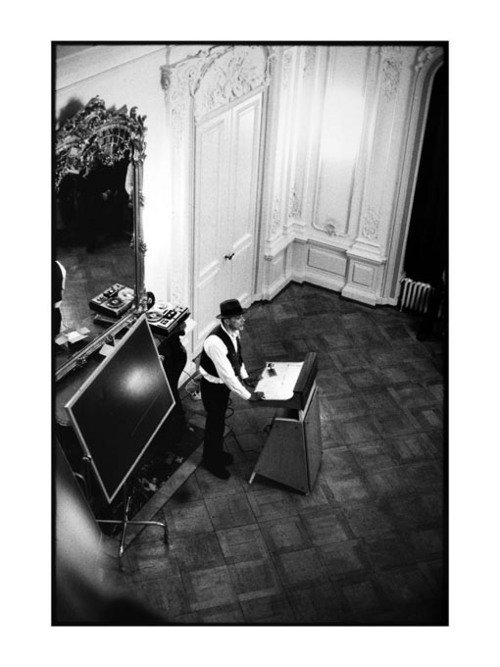Dietmar Schneider
dal 31/8/2006 al 13/10/2006
Segnalato da
31/8/2006
Dietmar Schneider
Galerie Bugdahn und Kaimer, Dusseldorf
Portraits from the Art World

"Portraits from the Art World"
Dietmar Schneider (born 1939) lives and works in Cologne. Since 1966 the "career hopper", who started his professional life by training as an insurance salesman, has successfully organized exhibitions, and since 1979 he has published the quarterly magazine "Kolner Skizzen" (Cologne Sketches). In addition, amongst other things he initiated successfully the "Kunstpreis Glockengasse" (an art prize) and the "Toyota-Fotokunstpreis" (an art photography prize). His photographic activities, which he had begun as an amateur, culminated in membership of the "DGPh" (the German Photographic Association). Initially Schneider understood his black and white photos, which as a rule are taken without a flash, as fleeting snapshots for the purpose of documentation. Meanwhile his archive, comprising of some 90,000 photographs, has developed over 30 years into a significant and priceless chronicle of the international as much as the regional art scene and of art history. Central to the archive is the art(work) along with its protagonists - collectors, artists, curators, gallerists and private-view visitors. From this extensive collection Galerie Bugdahn und Kaimer is showing a selection of about 35 gelatine-silver prints in the format of 30 x 40 cm (13 x 19 inches) with an edition of 9 for each print.
Through his contacts, which he has built up and maintained over the years, Dietmar Schneider moves round the art-world stage confidently but at the same time virtually invisibly. In many cases friendships have developed, enabling an intimacy in which portraits of great authenticity, accuracy and immediacy have been created. The relaxed faces and the naturalness of the body language are witness to this. However, with all this privacy, which can be seen in his images, he always remains discreet and keeps a respectful distance. Likewise there are subjects who enjoy their exposure in the limelight (for example the nonchalantly posed Jannis Kounellis, the agitated-provocative Jorg Immendorf or the grand gentleman James Lee Byars), and those shy, introverted personalities Schneider also does justice to - a photograph of Sigmar Polke in front of a canvas, turning away from the viewer, or one of Tony Cragg in the very background of an installing situation, his face in half-shadow. Schneider has taken a lot of photos spontaneously, clicking at the "right" moment, documenting a situation he has come upon, but some settings were also consciously arranged by him - such as the picture of Meret Oppenheim with its unusual perspective. However, this is also done with a light touch, you never get the impression of complicated or pretentious compositions. Pictorial structures and compositional lines relate to the figure perfectly and coherently. Particularly those photos with two or more people in dialogue appear atmospherically loaded: When Heerich and Schwegler are involved in a discussion, Palermo and Knoebel face each other or Heerich, Beuys, Stuttgen and Schmela are completely engrossed in installing an exhibition. The viewer gets an insight into something, which would otherwise remain inaccessible - the "inner machine room" of the art apparatus. Not least, what is fascinating about Schneider's archive is that with curiosity and interest you expect to discover something new at any moment. Behind the interest in the nature of those portrayed is hidden our society's popular stereotype of the artist as an idealized blank screen onto which can be projected this special type of person who leads the "right" kind of life, which is both fulfilling and exciting. The fact that artists, on the other hand, portrait themselves accordingly, appears to be the logical consequence of this fantasy. The exhibition "Portraits from the Art World" confirms this thesis and contradicts it at the same time. Alongside the expected peacocks are many unspectacular, quiet situations, sensitively and movingly documented. Schneider's Oeuvre attains a fundamental depth by suggesting an implicit correspondence between the personality of the artist and his work and thereby questioning whether such an analogy is legitimate. The public demands information about the author who it perceives as the key to, or auratic guarantee of its reception of the work, and the photographs in the exhibition lay a seductive trail for their enquiry.
In Camera Lucida - Reflections on Photography Roland Barthes talks of the air (the expression, the look) as an important aspect of a kind of photography, in which recognition of a person leads to rediscovery: "The air of a face is unanalyzable ... the air is that exorbitant thing which induces from body to soul ... the air expresses the subject ...Thus the air is the luminous shadow which accompanies the body; and if the photograph fails to show this air, then the body moves without a shadow, and once this shadow is severed ... there remains no more than a sterile body. It is by this tenuous umbilical cord that the photographer gives life; if he cannot ... the subject dies forever." Photographs of Mario Merz and a hatless Joseph Beuys, which count among the strongest in this exhibition, anticipate what Barthes is driving at in these thoughts.
Gabriele Wurzel
Image: Joseph Beuys, Leverkusen, 1974, Gelatine Silver Print
Exemplar 4/9 40 x 30 cm / 16 x 12 inches GBK# DSR 26
Private View Friday, September 1, 2006 6 - 10 pm
Galerie Bugdahn und Kaimer
Dusseldorfer Strabe 6 . 40545 Dusseldorf Germany
Tuesday - Friday 1 pm - 7 pm, Saturday 12 noon - 4 pm; and by appointment



